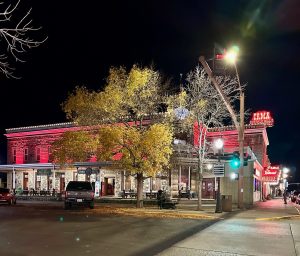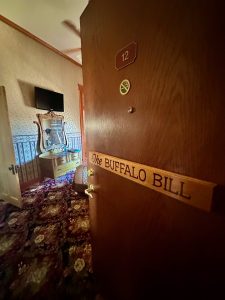Sleeping in Buffalo Bill’s Bed (Kind Of)
CODY, WYOMING – We booked Room #12 at the Irma Hotel, built in 1902 by William Frederick Cody for $80,000 – about $3 million today. Cody, better known as Buffalo Bill, called it “just the sweetest hotel that ever was.”
A wooden sign on the door of #12 proclaims we are indeed staying in The Buffalo Bill. Col. Cody, as he was usually called, maintained two suites and an office at the Irma. We are staying in one of those suites, which is about the size of a small one-bedroom apartment. It has a spacious living room with a soft leather couch and a nice view of Cody (the town) from the suite’s large second-floor windows.
In the bathroom there is a clawfoot tub that is tricky to step into with short legs. The shower head descends from the ceiling, meaning one gets a cold slap of water in the face when turning on the tub’s faucet. There is an old-fashioned commode with the tank mounted to the wall above the bowl, and a chain to pull for flushing. In the bedroom, above an ornately carved headboard, is a large photograph likely taken at the hotel’s grand opening. Buffalo Bill is on horseback holding a young child – not Irma, who was 19 when the hotel was built. A grandchild perhaps, but not one of Irma’s. Her children were born a few years later.
Irma died in 1918 during the great flu pandemic at 35. Her husband, Fred, managed the hotel but also fell victim to the flu, dying just three days after Irma. Her ghost, dresse d in white, is rumored to roam the hotel’s hallways at night. We did not happen upon her ghost during our two nights staying just down the hall from the Irma Suite, Room 16. The hotel is filled with antiques both living and inert; the dining room is clearly popular with locals. The back bar in the restaurant is built of cherrywood. It was given to Cody by Queen Victoria after he gave a private performance for her Golden Jubilee.
d in white, is rumored to roam the hotel’s hallways at night. We did not happen upon her ghost during our two nights staying just down the hall from the Irma Suite, Room 16. The hotel is filled with antiques both living and inert; the dining room is clearly popular with locals. The back bar in the restaurant is built of cherrywood. It was given to Cody by Queen Victoria after he gave a private performance for her Golden Jubilee.
It is fitting that the city of Cody, named for one of the most famous celebrities on the planet at the turn of the 20th century, thrives and survives on tourism and rodeos. It calls itself the Rodeo Capital of the World, holding an amateur rodeo every night from June 1 through Aug. 31. Western art dominates the large selection of galleries along the main highway. The Buffalo Bill Center of the West contains five highly regarded museums.
Cody, population about 10,000, is a popular gateway to Yellowstone National Park a few hours west, one of the reasons we are here on fall break. The Shoshone River flows through town in a canyon. Heart Mountain, 8,123 feet, is about 9 miles north of town and is easily visible.
William Cody became Buffalo Bill at the tender age of 23, after serving in the Union army during the Civil War and as a civilian scout during what are called the Indian Wars, largely intended to relocate and/or eradicate Native Americans in the West so white settlers could live there. He supposedly killed more than 4,000 buffalo in 18 months to supply the Kansas Pacific Railroad with meat. A Western writer named Ned Buntline serialized his exploits for a New York newspaper, taking generous liberties with the truth. Cody appeared on stage in several of Buntline’s Wild West shows, then started his own troupe in 1883 – Buffalo Bill’s Wild West. Supporting “actors” included Annie Oakley, Sitting Bull and Calamity Jane.
I have long wanted to visi t Cody, located in Park County about 40 miles south of the Montana border. It is definitely a haul from Behind the Pine Curtain, somewhat explaining the delay. We flew to Denver, rented a Jeep with big tires (it seemed fitting) and drove nearly 500 miles to get there. Along the way we stopped in Cheyenne (the state capital), Douglas and Casper, the latter two because of family ties. My great-grandfather and his son (my paternal grandfather) moved from Michigan to homestead two sections (1,280 acres) 50 miles northwest of Douglas, starting in 1917. My grandfather, who in the 1970s recorded an oral history of his experience, was 11 at the time.
t Cody, located in Park County about 40 miles south of the Montana border. It is definitely a haul from Behind the Pine Curtain, somewhat explaining the delay. We flew to Denver, rented a Jeep with big tires (it seemed fitting) and drove nearly 500 miles to get there. Along the way we stopped in Cheyenne (the state capital), Douglas and Casper, the latter two because of family ties. My great-grandfather and his son (my paternal grandfather) moved from Michigan to homestead two sections (1,280 acres) 50 miles northwest of Douglas, starting in 1917. My grandfather, who in the 1970s recorded an oral history of his experience, was 11 at the time.
Carl Basil Borders is why we are in Cody on a brilliant autumn day, aspen leaves glowing in iridescent yellow, a constant cool breeze at our backs as we explore the many shops lining Sheridan Avenue, the city’s main street. After an unsuccessful run for sheriff, in 1943 my grandfather left his job as a desk sergeant with the Casper Police Department and became a professional Boy Scout, soon ending up in Cody as a field executive. In that position, he was in charge of 350 Japanese American boys who joined the Boy Scouts while confined during World War II to the Heart Mountain Relocation Center, an internment camp north of town.
That is a story for another week.
Leave a reply
Fields marked with * are required











